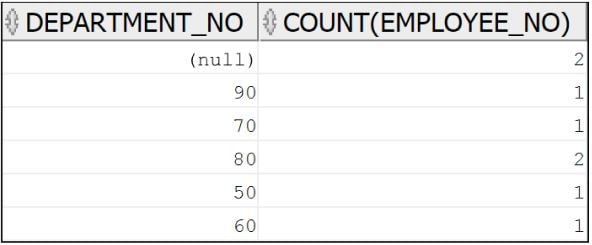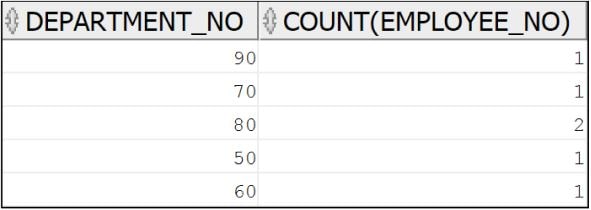How Can We Help?
Introduction:
In this tutorial, we are going to explain how to use Oracle COUNT function. with basic syntax and many examples for better understanding.
COUNT function returns the number of rows returned by the query. We can use this function as an analytic or aggregate.
Syntax:
COUNT({ * OR ALL OR DISTINCT } aggregate_column)
SELECT column1, column2, column3, ... column_n,
COUNT(aggregate_column)
GROUP BY column1, column2, column3, ... column_n;
| Name | Description |
| COUNT (*) | Function returns the number of rows including null values. |
| COUNT (ALL) | Function returns the number of rows which is not null. |
| COUNT (DISTINCT) | Function returns the number of unique values. |
| aggregate_column | Column or expression that will be counted by count function |
| column1,column_n | Columns selected with aggregated COUNT function. And we must include them all in GROUP BY clause. |
| GROUP BY column1 | If we use columns along with count(column) in SELECT clause, so we must include them in GROUP BY clause to aggregate the result of COUNT by those columns. |
Applies to::
Oracle 19c, Oracle 18c, Oracle 12c, Oracle 11g, Oracle 10g, Oracle 9i, Oracle 8i
Sample Setup:
DROP TABLE emps PURGE;
CREATE TABLE emps (
employee_no NUMBER CONSTRAINT pk_emps PRIMARY KEY,
name VARCHAR2(50),
salary NUMBER(10,2),
comission NUMBER(10,2),
manager_no NUMBER,
department_no NUMBER
);
Data Insertion:
INSERT INTO "HR"."EMPS" (EMPLOYEE_NO, NAME, SALARY, DEPARTMENT_NO) VALUES ('100', 'Steven', '24000', '90');
INSERT INTO "HR"."EMPS" (EMPLOYEE_NO, NAME, SALARY, MANAGER_NO) VALUES ('143', 'Layla', '2600', '124');
INSERT INTO "HR"."EMPS" (EMPLOYEE_NO, NAME, SALARY, COMMISSION, MANAGER_NO, DEPARTMENT_NO) VALUES ('145', 'John', '14000', '5600.00', '100', '80');
INSERT INTO "HR"."EMPS" (EMPLOYEE_NO, NAME, SALARY, COMMISSION, MANAGER_NO, DEPARTMENT_NO) VALUES ('146', 'Seleem', '13500', '4050.00', '100', '80');
INSERT INTO "HR"."EMPS" (EMPLOYEE_NO, NAME, SALARY, COMMISSION, MANAGER_NO) VALUES ('161', 'Magy', '7000', '1750.00', '146');
INSERT INTO "HR"."EMPS" (EMPLOYEE_NO, NAME, SALARY, COMMISSION, MANAGER_NO, DEPARTMENT_NO) VALUES ('170', 'Mark', '10500', '1055.00', '161', '70');
INSERT INTO "HR"."EMPS" (EMPLOYEE_NO, NAME, SALARY, COMMISSION, MANAGER_NO, DEPARTMENT_NO) VALUES ('175', 'Louise', '12900', '4610.00 ', '100', '60');
INSERT INTO "HR"."EMPS" (EMPLOYEE_NO, NAME, SALARY, COMMISSION, MANAGER_NO, DEPARTMENT_NO) VALUES ('179', 'Rose', '15450', '3010.00', '170', '50');
COMMIT;
Sample Data:
| Employee # | Name | Salary | Commission | Manager # | Department # |
| 100 | Steven | 24,000 | 90 | ||
| 143 | Layla | 2,600 | 124 | ||
| 145 | John | 14,000 | 5600.00 | 100 | 80 |
| 146 | Seleem | 13,500 | 4050.00 | 100 | 80 |
| 161 | Magy | 7,000 | 1750.00 | 146 | |
| 170 | Mark | 10,500 | 1055.00 | 161 | 70 |
| 175 | Louise | 12,900 | 4610.00 | 100 | 60 |
| 179 | Rose | 15,450 | 3010.00 | 170 | 50 |
Examples:
Let’s take some examples about Oracle COUNT and how to use it:
(1) Using COUNT(*) example
SELECT COUNT(*) FROM emps;

(2) Using COUNT with DISTINCT clause example
SELECT COUNT(DISTINCT DEPARTMENT_NO) FROM emps;

NOTE: there are two employees that hasn’t department assigned. Our function eliminates those rows from counting the departments.
(3) Using COUNT with ALL clause example
SELECT COUNT(ALL commission) FROM emps;

(4) Using COUNT in WHERE clause example
SELECT COUNT(*) FROM emps WHERE SALARY > 8000;

(5) Using COUNT in GROUP BY clause example
SELECT department_no,
COUNT(employee_no)
FROM emps
GROUP BY department_no;

notice that there are two employees doesn’t assigned to department yet.
(6) Using COUNT in GROUP BY clause and eliminating NULL values example
SELECT department_no,
COUNT(employee_no)
FROM emps
WHERE DEPARTMENT_NO IS NOT NULL
GROUP BY department_no;

See the previous example (5) to imagine the difference between both examples.
(7) Using COUNT in GROUP BY & having clauses example
SELECT department_no,
COUNT(employee_no)
FROM emps
WHERE DEPARTMENT_NO IS NOT NULL
GROUP BY department_no
HAVING COUNT(EMPLOYEE_NO) > 1;

See the previous example (6) to imagine the difference between both examples.
Similar functions to Oracle COUNT:
SUM : returns the sum of expression or columns.
ROUND : rounds the column, expression, or value to n decimal places.
GREATEST : returns the greatest value of given list of values.
LEAST : returns the smallest value of given list of values.
ABS : returns the absolute value of a number value passed to.
In this tutorial. You have learned how to use the Oracle COUNT function to count the number of rows returned by the query.
We have demonstrated more than 6 examples. To showcase different use of COUNT function in oracle.
Hopefully, it was clear and concise.




